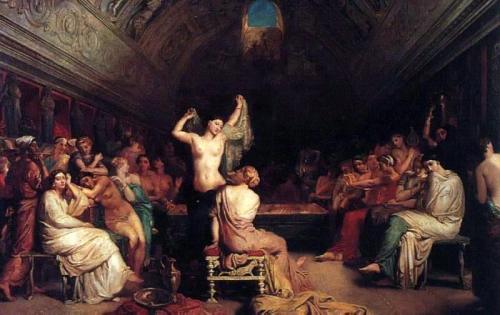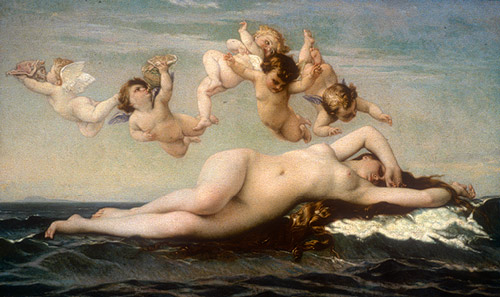Nineeenth Century Academic* Painting
The term "academic" is often used to describe the official sanctioned painting in France in the 19th century because the style was associated with the French Academy of Fine Arts
By the middle of the 19th century the domination of painting by the official academies in Western and Central Europe had produced an art that was highly refined
Théodore Chassériau (1819-56) The Tepidarium (1853) Chassériau was a successful French academic painter of the mid-19th century. He was a pupil of Ingres with whom he began studying at the age of 11. He accepted Ingres’ emphasis of clear lines in his paintings, but in the 1840s he also became fascinated with the more dramatic sue of color in the most Romantic works of Delacroix. This painting of an ancient Roman bath is a good example of the concern with archaeological realism in 19th century academic painting. |
and, from the point of view of most 20th century critics, somewhat sterile. Working within this system young artists competed for the favor of older painters in competitions for awards, such as the high prestigious Prix de Rome, and for the right to exhibit their works in the annual Salons, which not only provided artists with the opportunity to find buyers for their work but also gave their work an semi-official stamp of approval.
The focus on technique does not, however, indicate that these artists were merely interested in accurately reproducing physical reality. They believed that art could be a privileged route to a deeper truth and should be morally uplifting. Only a limited number of subjects (genres) were considered worthy vehicles for such high themes.
Thus, academic artists painted themes borrowed from religion, classical mythology, and history. Scenes of landscapes or (worse) of everyday moments in 19th century life were considered too insignificant to be the subject of great art. From our perspectives many of the paintings of the period seem quite explicitly erotic and often degrading to women, but within the world of official painting at the time it was believed that they were uplifting examples of pure beauty.
Acceptance within this system rested largely on the ability to master the demanding technical requirements of the “realistic” style dominant at the time. Painters were expected to create the impression that their work was a “window” onto a particular scene. All signs of their brush strokes were to be hidden, and the use of foreshortening and subtle shading was to create the illusion of three dimensional space. In following such techniques artists believed that they were continuing a tradition that stretched back to ancient Greece and rediscovering the same ideals of beauty that had inspired Western art throughout history.

